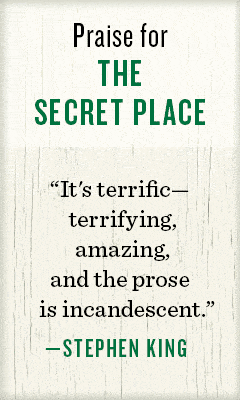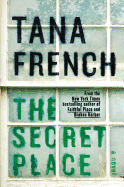The Secret Place
by Tana French
Since his turn as Frank Mackey's sidekick in The Faithful Place, Detective Stephen Moran has been biding his time working in Cold Cases but hoping to get his foot in the door with the Murder Squad. "Murder is the thoroughbred stable. Murder is a shine and a dazzle.... Murder is a brand on your arm, like an elite army unit's, like a gladiator's, saying for all your life: One of us. The finest." He gets his lucky break in the form of Mackey's daughter, Holly. As a little girl, Holly was a witness in a murder trial. Now a teenager attending the prestigious girls' boarding school St. Kilda's, she's barely recognizable to Moran when she ditches school and shows up at the station. In her hands is a postcard with the words "I know who killed him" glued across a picture of Chris Harper, a popular, handsome student from the neighboring boys' school who was found dead on the campus of St. Kilda's months ago.
Moran uses the card and his rapport with Holly to bargain himself into the investigation alongside Detective Antoinette Conway, an ambitious officer two years Moran's junior. With a mind as sharp and bright as steel, Conway has thrived in the midst of barely concealed sexism and suspicion from the predominantly male police force through focus, talent and force of will. Just as Moran never pictured his ideal partner as a tough-as-nails inner-city Dubliner--he'd prefer someone with a posh accent who raises Irish Setters and plays the violin--Conway has little use for Moran, who retains his awe at the rarefied air of St. Kilda's even after he learns its other side, who "still couldn't picture bad things here: someone being bitch-whipped out of a conversation into one of those corners, someone snug in one of the sofas longing to cut herself." Unexpectedly, the pair find themselves quickly bonding, Moran's universal likability and optimism making him the perfect good cop to Conway's cynical, bullish bad cop. As they face down a tight-lipped headmistress, a bevy of teen girls who may as well have "razor blades in their hair," and a ticking clock before they're shoved off the school grounds, Moran and Conway must learn to trust each other if they're going to catch a killer.
On the other side of the interrogation table sit eight teenage girls, two cliques of four. One clique, nicknamed the Daleks and headed by a poisonous queen bee named Joanna, embody the putdowns, shaming and fear-mongering associated with the worst side of adolescence. The other, made up of Holly and her friends Selena, Becca and Julia, are the other side of the coin, a solid wall of sisterhood and loyalty, "the something else I'd been looking for. Burning hotter, throwing off sparks in strange colors," Moran thinks. In chapters that alternate with Moran and Conway's investigation, readers come to know Holly and her mates well as they live out the months between the beginning of the previous school year and Chris Harper's murder. Sarcastic Julia, daydreamer Selena, brainy but shy Becca and clever Holly complement each others' personalities perfectly, and the support and approval they derive from one another allow them to flout the power dynamics and popularity games that dominate the lives of their classmates. For a while, their insular world is an Eden, but "in a grassy and moonless silence between two secrets," a blend of misunderstandings, jealousy and the venomous machinations of Joanna and company exact a heavy price for their idyll. Out of eight girls, only one knows the truth behind Chris Harper's murder, and readers will change their minds about the culprit again and again until all is revealed.
French nails the mindset of adolescence in a way that will leave readers with little nostalgia for their teenage years: the desperation to fit in without knowing how, the dangerous new worlds of sex and drugs, the sudden transition of adults from caretakers to enemies of freedom. At the same time, she acknowledges that life as a grown-up isn't without its bullies and popularity contests. Conway faces sexism at work, while Moran is still seen by some as Mackey's lapdog, and both of them see St. Kilda's as representative of a world they cannot touch. French expertly lays bare the striations of age, class and gender that keep people apart while making them need each other more. With carefully crafted characters and motives, French not only makes a boarding school murder seem plausible, she makes the reader wonder how teenagers could ever live in such close quarters without doing each other grievous bodily harm. Even those who truly believe in the innocence of adolescence will turn the final page sure of Moran's lesson: " 'If I've learned one thing today, it's that teenage girls make Moriarty look like a babe in the woods.' " --Jaclyn Fulwood








